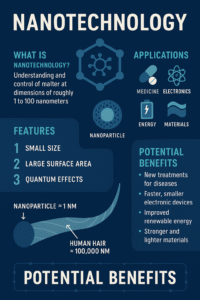Nanotechnology is the science of studying and using materials at a very ti ny scale, called the nanoscale. A nanometre (nm) is incredibly small—1 billionth of a metre. To put this into perspective, a human hair is about 80,000 nanometres wide! Nanotechnology deals with materials that are between 1 and 100 nanometres in size.
ny scale, called the nanoscale. A nanometre (nm) is incredibly small—1 billionth of a metre. To put this into perspective, a human hair is about 80,000 nanometres wide! Nanotechnology deals with materials that are between 1 and 100 nanometres in size.
How Materials Change at the Nanoscale
When materials are shrunk to the nanoscale, their properties—like how they conduct electricity, their strength, colour, and chemical behaviour—change dramatically. These changes are called nanotransformation, and they can be very useful. By controlling materials at this level, scientists can make improved devices, materials, and systems.
For instance, graphite, a form of carbon we use in pencils, is hard and conducts electricity and heat well. However, when transformed into graphene at the nanoscale, it becomes 200-300 times stronger than steel, one of the best conductors of electricity and heat, and it turns transparent. This change in properties makes graphene a super material for electronics, construction, and even medical devices.
Origins of Nanotechnology
The idea of using materials at such small scales was first suggested by Professor Richard Feynman, a famous scientist who won a Nobel Prize. He believed that, at such a tiny scale, materials would behave differently and offer exciting new possibilities. The term “nanotechnology” was later coined by Japanese scientist Taniguchi Norio.
A key discovery in this field happened in 1985, when scientists stumbled upon buckyballs (also called fullerenes). These are spherical molecules made entirely of carbon, with Carbon-60 being the most stable form. Buckyballs have special properties that are still being researched for use in electronics, medicine, and other fields.
Examples of Changed Properties at the Nanoscale
- How Materials Look:
- Gold: In its normal form, gold is yellow. However, when broken down to nanoscale particles, it can appear orange, red, pink, or even black, depending on the size of the particles.
- Zinc Oxide: Normally, zinc oxide used in sunscreens leaves a white patch on the skin. But when turned into nano-sized particles, it becomes transparent, offering the same protection without the white residue.
- Graphite: This material is opaque at the regular scale but turns transparent when reduced to graphene.
- How Materials Conduct Electricity:
- Graphite: While it’s a good conductor of electricity, graphene (its nanoscale form) is the best conductor of heat and electricity, which makes it ideal for electronic devices and batteries.
- Metals: Metals like copper can become less conductive at the nanoscale, which means scientists are exploring other materials like graphene to improve the efficiency of electronic devices.
- How Materials React:
- Aluminium Oxide: Normally, aluminium oxides are stable and don’t react easily. However, at the nanoscale, they become highly reactive, even explosive, making them useful in industries like mining and road construction in difficult terrains.
- How Strong Materials Are:
- Graphite: At the regular scale, graphite is hard, but graphene is about 100 times stronger than steel while being much lighter. This makes graphene a perfect candidate for use in aerospace and sports equipment.
- Carbon Fibres: Normally soft materials like charcoal become extremely strong and lightweight at the nanoscale, which is why carbon fibre is used to reinforce tennis rackets, bicycle frames, and even aircraft.
MCQs For Prelims
Consider the following statements about the properties of materials at the nanoscale:
- Gold appears orange, red, or pink at the nanoscale.
- Zinc oxide becomes transparent at the nanoscale.
- Graphene conducts electricity less efficiently than graphite.
Which of the above statements is/are correct?
A) 1 and 2 only
B) 1 and 3 only
C) 2 and 3 only
D) 1, 2, and 3
Answer: A
Explanation: Statement 1 is correct as gold exhibits different colours (orange, red, pink, etc.) at the nanoscale. Statement 2 is also correct because nanoscale zinc oxide becomes transparent. However, statement 3 is incorrect—graphene conducts electricity better than graphite.
2. Which of the following discoveries is associated with nanotechnology and involves spherical molecules made entirely of carbon?
A) Quantum dots
B) Fullerenes or Buckyballs
C) Carbon nanotubes
D) Graphene
Answer: B
Explanation: Fullerenes, also known as buckyballs, are spherical carbon molecules discovered by chance in 1985, and they are closely associated with the field of nanotechnology.
